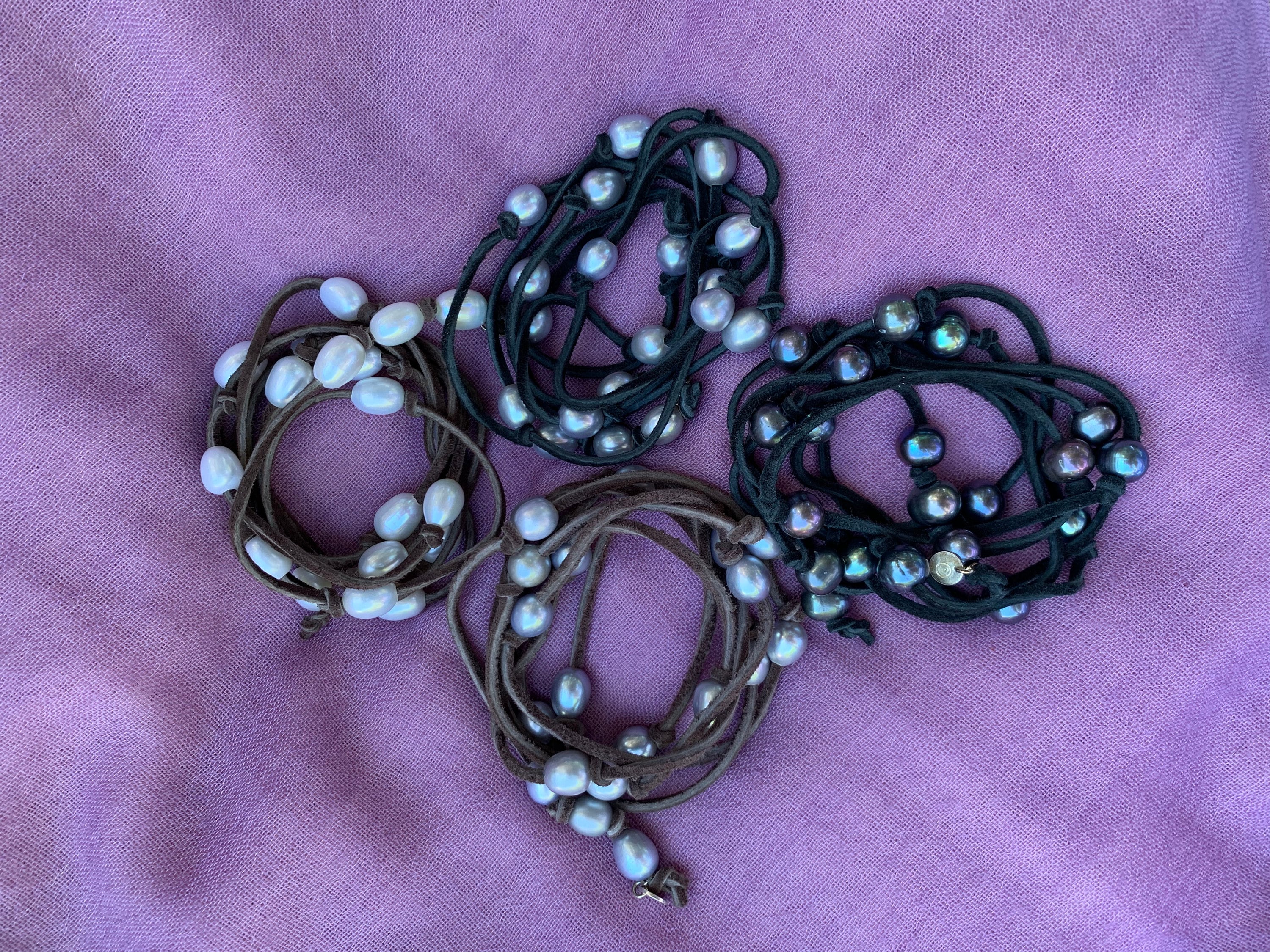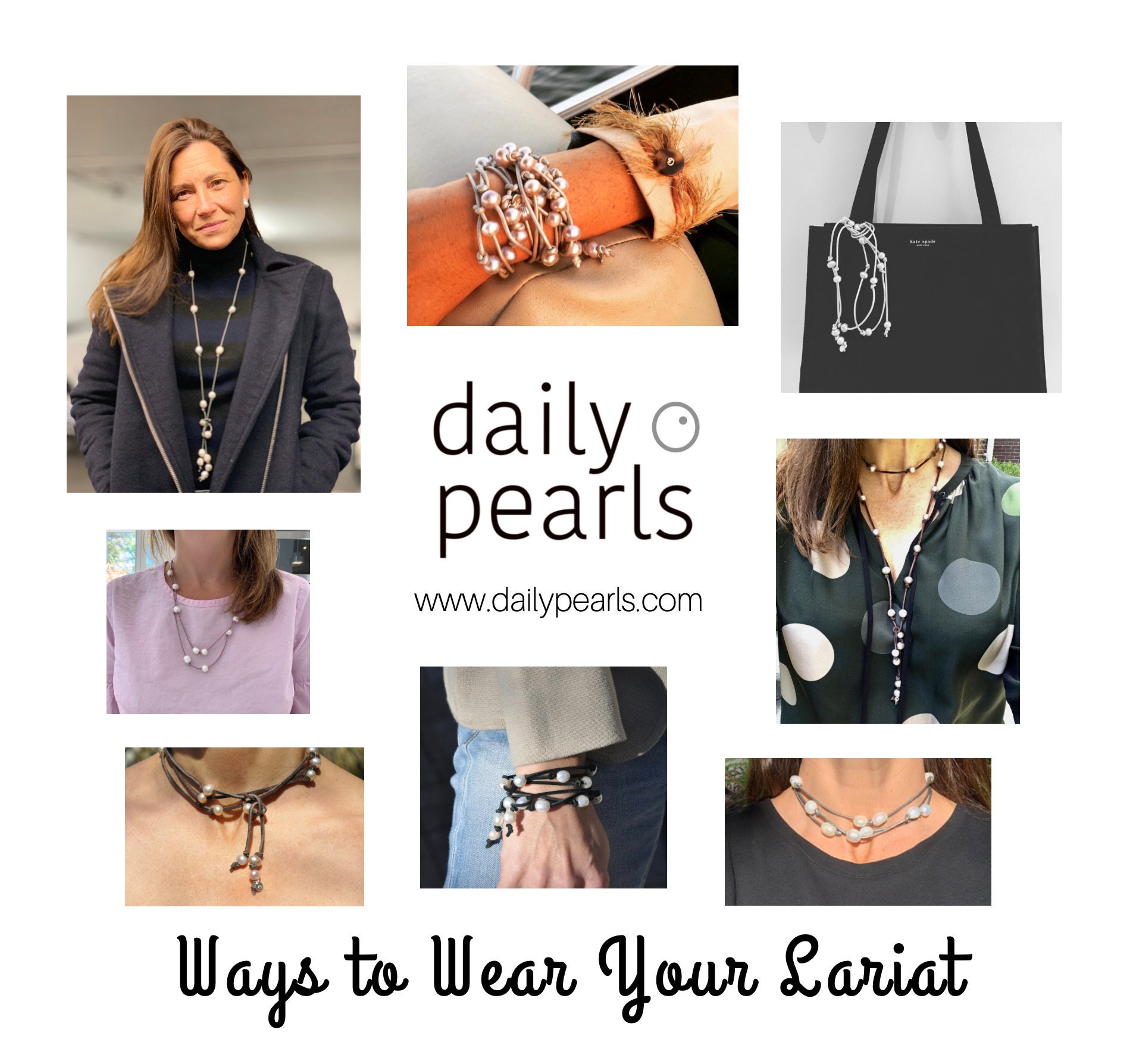Brown or Black Suede Rope with Regular or Large White, Grey, Gold or Peacock Pearls, Easy to Wear as Wrap Bracelet or Necklace
$69.57
These ropes, or lariats, are one of our best and longest-selling items. They've got the beauty and elegance of pearls in an easy, everyday style. Women of all ages love them, since there are so many ways to wear them, and the "wrap" style is on-trend. This makes them a great gift -- as well as a practical item for your jewellery box. You'll receive the card, pictured above, which shows different ways to wear it.
Although the ropes can be worn many ways, most women are drawn to wearing them either as a bracelet or a necklace. Because of this, we make them using a few different leathers (outlined below).
This rope, in suede, works equally well as a bracelet or a necklace of any style. It's a little earthy, but in black and dark brown suede, is still very chic. If you are drawn to suede but not sure what colour pearls to go with:
Dark brown suede is more organic of the two. Our favourite combination with dark brown is grey, which feels organic-sophisticate. Gold pearls are warm and beautiful. Peacock pearls (which are almost black) add a dramatic feel. And white is almost country-western.
Black suede is the dressier of the two, and white pearls are the most classic option here. Grey pearls up the sophistication. And peacock pearls with black are all drama.
We also make lariats in metallic leather cord, which are urban casual.
Thick metallic leather with large pearls ($165 CAD) works equally well as a bracelet or a necklace. With regular pearls ($95 CAD), it is the best choice for wear as a bracelet. It can be worn as a long necklace, but it doesn't hang quite as well as thin metallic leather.
Thin metallic leather ($85) hangs best as a necklace of any length. It can feel a bit light as a bracelet, but if you layer your bracelets, you won't mind this at all.
To keep your pearls looking their best, they should be the last thing you put on and the first thing you take off. Avoid getting perfume, hairspray, lotion, or any other chemical on them, and wipe them off right away if you do. Keep them out of water, where hair products, chlorine, or salt water could dull or discolour them. Water can also weaken the bond between the pearl and the post.
As popular as pearls are, the range of varieties and prices can get confusing. Here's what you need to know:
1) Almost every real pearl on today's market, regardless of variety, is “cultured.” A cultured pearl is grown in an ocean or a lake, and develops around a nucleus or irritant which is placed in an oyster or mollusk. The final product is created by nature, albeit with man’s help.
2) “Natural” pearls are pearls that have been found in oysters. Natural pearls found today sell for tens of thousands of dollars. Many natural pearls on the market are in antique pieces, and come with gemological x-ray certification.
3) The highest-priced cultured pearls are cultured in seawater, and there are three main varieties: Akoya, Tahitian, and South Sea. Akoya pearls, grown off the coast of Japan, were the first saltwater pearls to be cultured, and became the "classic" pearls your grandmother might have worn. Tahitian pearls, which are grown around Tahiti, grow naturally in shades of grey and black, and were developed in the 1970s. South Sea pearls, grown in the Southern Hemisphere, were developed more recently, and are considered by many to be the most desirable pearls.
4) Daily Pearls makes jewellery from cultured freshwater pearls, which are the most affordable variety of cultured pearls. China produces most of the world's freshwater pearls, many of which are unusually shaped, or "baroque."
5) Plastic or glass imitations of cultured pearls are called “simulated” pearls. You can tell the difference between cultured and simulated pearls by touching one to the top of your bottom teeth. If it feels gritty, the pearl is real. If it feels like plastic or glass, it is not a cultured pearl.
Let us know if we can help you with your pearl shopping!








